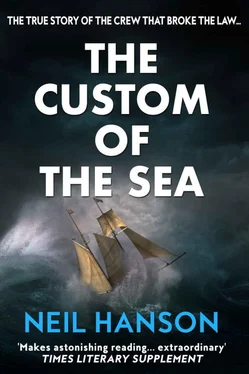Sixty-nine men eventually reached the shore. Another fifty clung to the rigging of the mainmast, which was still protruding above the water. Many, exhausted, fell to their death during the remainder of the night, but thirty were still there when they were rescued by a passing schooner the next morning.
Of the 648 people on board the Birkenhead , only 193 were saved, including all the women and children. Seton and Salmond were among those lost. The official report by one of the survivors, Captain Wright, said,
The order and regularity that prevailed on board from the time the ship struck until she totally disappeared far exceeded anything that I thought could be effected by the best discipline, and is more to be wondered at seeing that most of the soldiers had been but a short time in the Service. Everyone did as he was directed and there was not a murmur or cry among them until the vessel made her final plunge.
The example of the Birkenhead , ‘To stand and be still in the Birkenhead drill,’ in Kipling’s words, was henceforth held up as the model others should follow.
The less exalted circles in which seamen moved preferred to hold to the custom of the sea, and despite the hostility of polite society to the practice few attempts had been made to test its legality. Since the unsuccessful trial of the men wrecked off St Christopher in the early seventeenth century, only two cases had been brought. The survivors of the Euxine faced only cursory court proceedings in Singapore and were released without facing trial in London.
The other case involved Alexander William Holmes, an able seaman on an American ship, the William Brown . The 550-ton ship had left Liverpool for Philadelphia with a crew of eighteen under Captain George Harris, sixty-five passengers and a full cargo of general goods. Late in the evening of Monday, 19 April 1841, the ship was running before a south-westerly gale about 250 miles from Newfoundland when she struck ice floes. The impacts stove in the bows and the ship began to sink almost at once.
The passengers scrambled from their berths and went on deck, but there were only two boats. Captain Harris, the second mate, six sailors and the cabin boy got into the jollyboat with one passenger, Eliza Lafferty, whose preferential treatment can only have been based on intimacy with Harris. Even her sister was turned away from the boat.
The first mate, Francis Rhodes, got into the longboat with Holmes, seven other sailors and a further thirty-three passengers. Holmes had already helped several people into the longboat and then climbed back on board to rescue a child of one of them, returning with her clinging to his back. A woman on deck offered him a year’s wages to rescue her too, but he refused, saying he was ‘not after money but saving lives’.
Holmes was ‘the last person to leave the sinking ship’. Despite their entreaties, the remaining thirty people were left on board. They all drowned when she went down at eleven twenty that night.
Harris had given Rhodes a watch, compass, quadrant and chart and told him the course to take, but conditions in the desperately overcrowded longboat were appalling. Few of the passengers had more than their nightclothes, the boat had lost its rudder and its drainage plug, and also had another leak. The holes were crudely blocked, but the leaks were so bad that the boat had to be baled continuously, and it rode so low in the water that it was at constant risk of foundering in the heavy swell.
The jollyboat remained alongside during the night but at dawn Captain Harris announced his intention of making sail for land, leaving the others to their fate. Rhodes told him that unless some of the passengers were transferred to the jollyboat, he would be forced to lighten the longboat by throwing them overboard.
The captain refused to take them and said, ‘I know what you mean. Don’t speak of that now, let it be the last resort.’
The captain and his fortunate company sailed away. The sailors in the longboat manned the oars and began to row south, towards the main shipping lanes, but by evening they were surrounded once more by ice.
According to his later testimony, Rhodes ‘thought it improbable that she could hold out, unless relieved of some of her weight. I then consulted the sailors, and we were all of the opinion that it was necessary to throw overboard those who were nearly dead.’ Some time later, Rhodes threw down the baler, and said to the crew, ‘This work won’t do. Help me, God. Men, go to work.’
He had to repeat the instruction — he later claimed it was not an order, but merely a statement of their predicament — before the crew began their grisly task. Holmes and at least four others began throwing the sixteen male passengers overboard.
Despite pleas for mercy and offers of money, a succession of men were thrown out of the boat. One man had two sisters in the longboat. When one volunteered to die in his place, the crew threw him out first and then said the sisters might as well go too and pitched them after him.
Two men were spared on the intercession of the mate, because their wives were also in the longboat; two more hid among the women and were not discovered until daybreak; then they, too, were tossed overboard. By the time the crew had finished their work, only two male passengers remained alive.
Holmes had been one of the ringleaders in the early stages of the killing, but he later relented and tried without success to prevent two other crewmen from murdering the last two victims. ‘No more shall be thrown over. If any others are lost, we shall be lost together.’
By a cruel irony, not long after the last two men had been thrown overboard, a ship, the Crescent , was sighted. Holmes forced the surviving passengers to hide in the bottom of the boat. ‘Lie down every soul of you, and lie still. If they make out so many of us on board, they will steer off another way and pretend they have not seen us.’
The Crescent stopped and picked them up just in time; the longboat was crushed by the ice shortly afterwards. Most of the survivors were transferred to another, larger ship, the Ville de Lyons , and as soon as it made port in Le Havre, the passengers contacted the American and British consuls, who secured the arrest of the crew.
Press reports criticized the crew’s failure to cast lots or make any rational choice between those who were to live or die, but none criticized the act itself. The consuls took depositions from all but one of the survivors but their sole interest seems to have been to hush up the incident. Each of the survivors’ curiously similar statements exonerated the crew. The consuls then issued a joint report claiming, ‘We have not discovered any fact capable of drawing down blame upon anyone whatever.’
The crew were released from gaol and took ship for America on the next available boat, while The Times remarked, ‘The frightful necessity of sacrificing part of the passengers for the safety of the rest is fully proved.’
It did not appear so to Lord Palmerston, who excoriated the British consul in a series of telegrams, claiming that he had gone out of his way to justify ‘a transaction which was revolting in its character… in which so many British Subjects were violently put to death by Foreigners… The perpetrators cannot be absolved from great apparent guilt except by the result of a legal tribunal.’
Since the crew had already sailed, however, no further action was possible. Lord Palmerston’s last comment on the affair was appended to the Foreign Office file: ‘This was a calamitous event and nothing more needs to be said about it.’
The anger of the survivors burned much more fiercely on their return to America than it had in Le Havre. Their complaints to the authorities in Philadelphia eventually led to the arrest of Alexander William Holmes. Neither the captain, nor the mate, nor any of the other crew was ever charged.
Читать дальше











